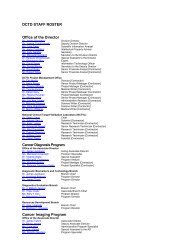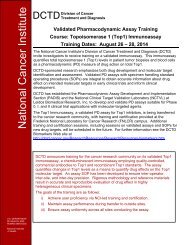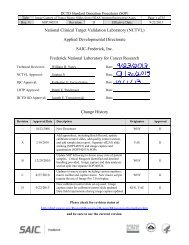National Cancer Institute - NCI Division of Cancer Treatment and ...
National Cancer Institute - NCI Division of Cancer Treatment and ...
National Cancer Institute - NCI Division of Cancer Treatment and ...
Create successful ePaper yourself
Turn your PDF publications into a flip-book with our unique Google optimized e-Paper software.
exp<strong>and</strong>ed clinical evaluation. Tasks<br />
supported by RAID include:<br />
■ Large-scale synthesis <strong>and</strong> formulation<br />
■ Pharmacology <strong>and</strong> toxicology<br />
■ In vivo screening<br />
■ Developmental tasks necessary to<br />
translate discoveries to the clinic<br />
■ Regulatory affairs, so that FDA<br />
requirements are likely to be satisfied<br />
by participating investigators seeking to<br />
test new molecular entities in the clinic<br />
RAID is not a mechanism for obtaining<br />
grants. To access the services <strong>of</strong> the RAID<br />
program, academic researchers may submit<br />
applications twice yearly—February 1<br />
<strong>and</strong> August 1. Submissions are reviewed by<br />
a panel <strong>of</strong> extramural experts who assess<br />
the strength <strong>of</strong> hypothesis, scientific novelty,<br />
<strong>and</strong> cost-benefit ratio <strong>of</strong> the project.<br />
Once a project is accepted, DTP provides<br />
drug development resources free <strong>of</strong><br />
charge. The output <strong>of</strong> RAID activities<br />
will be both products <strong>and</strong> information<br />
made fully available to the originating<br />
investigator for support <strong>of</strong> an IND<br />
application <strong>and</strong> clinical trials.<br />
Drug Development Group—<br />
for Academics <strong>and</strong> Industry<br />
http://dtp.nci.nih.gov/docs/ddg/<br />
ddg_descript.html<br />
Contact:<br />
Office <strong>of</strong> the Associate Director<br />
301-496-8720, ddg@dtpax2.ncifcrf.gov<br />
The Drug Development Group (DDG)<br />
meets monthly to consider developing<br />
drugs from discoveries in the <strong>NCI</strong> intramural<br />
<strong>and</strong> extramural academic communities,<br />
as well as the pharmaceutical industry,<br />
where the originators are certain at the<br />
outset that <strong>NCI</strong> should hold any resulting<br />
IND <strong>and</strong> manage any subsequent clinical<br />
trials. By contrast, the products <strong>of</strong> the<br />
RAID program will, in general, be returned<br />
directly to the originating investigator for<br />
clinical trials.<br />
Compounds at all stages <strong>of</strong> development<br />
are considered on an individual basis. The<br />
DDG will be responsible for oversight <strong>and</strong><br />
for preclinical <strong>and</strong> clinical decision-making<br />
at the key “go–no go” decision points. The<br />
DDG prioritizes use <strong>of</strong> DCTD resources supporting<br />
preclinical development by DTP<br />
<strong>and</strong> clinical development by CTEP, except<br />
that the Biological Resources Branch Oversight<br />
Committee (BRB-OC) governs acquisition<br />
<strong>and</strong> production <strong>of</strong> biologics approved<br />
by DDG.<br />
Initial presentation <strong>of</strong> an agent to the DDG<br />
requires an identified CTEP or DTP staff<br />
member to act as liaison. The <strong>NCI</strong> liaison<br />
coordinates with the originator, who supplies<br />
an application summarizing the tasks<br />
<strong>and</strong> support specifically being requested.<br />
In 2005, amin<strong>of</strong>lavone prodrug (NSC<br />
710464), produced by DTP, was one <strong>of</strong> the<br />
drugs that successfully made it through<br />
development under the auspices <strong>of</strong> the<br />
DDG, with an IND application filed with the<br />
FDA in early 2006. This drug may kill tumor<br />
cells without destroying bone marrow or<br />
having other toxic effects.<br />
Molecular structure <strong>of</strong><br />
amin<strong>of</strong>lavone prodrug<br />
(NSC 710464). An IND<br />
application was filed with<br />
the FDA in early 2006 for<br />
this DTP-produced drug.<br />
D E V E L O P M E N T A L T H E R A P E U T I C S P R O G R A M ■ 103










